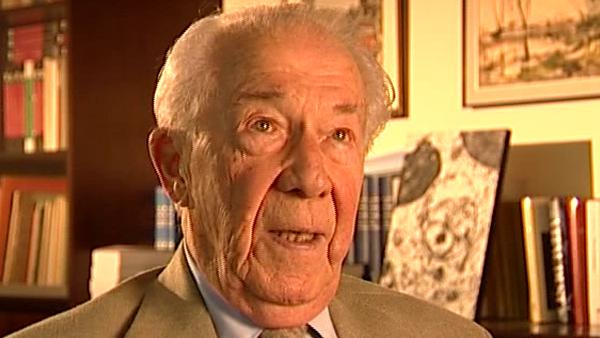NEXT STORY

Becoming Professor of Biochemistry at Louvain
RELATED STORIES

NEXT STORY

Becoming Professor of Biochemistry at Louvain
RELATED STORIES


|
Views | Duration | |
|---|---|---|---|
| 21. Writing to Carl Cori, and crystallised insulin | 206 | 03:14 | |
| 22. The Lilly Research Labs: Making a re-discovery | 203 | 03:40 | |
| 23. 'You will get a fur coat when I get a Nobel Prize' | 230 | 05:01 | |
| 24. Becoming Professor of Biochemistry at Louvain | 185 | 01:52 | |
| 25. Setting up a lab: A grant from Eli Lilly and Company | 151 | 02:40 | |
| 26. Setting up a lab: Difficulties getting equipment | 149 | 02:51 | |
| 27. Glucose 1-phosphate and glucose 6-phosphate | 187 | 03:55 | |
| 28. Purifying enzymes and visiting labs | 144 | 03:05 | |
| 29. The Rockefeller Institute and Albert Claude | 1 | 206 | 04:34 |
| 30. Centrifugal fractionation | 187 | 02:12 |


It was very hot and humid – that I remember very well; my wife remembers it even more than I do. But it was a very exciting time for two reasons. One was that Carl and Gerty got a wire from Stockholm saying that they had just been awarded the Nobel Prize for their discovery of glycogen phosphorylase. And that, of course, was very exciting, and we became the Nobel experts to... to help them, because when we were in Stockholm we had been invited to the Nobel ceremony, and Theorell was a member of the committee, and so he got us invited with the students there; so we had... we had seen this fantastic display when the prize is given, we had participated in the banquet and the dance and so on – it was all very exciting – and when we came out at two o'clock in the morning from the... the Stadshus, the town hall in Stockholm, it was bitterly cold... it was freezingly cold and we had to wait for our bus to get back to our apartment and my wife shivered. She said, 'Oh, I wish... I wish I had a fur coat.' And I said, 'You will get a fur coat when I get a Nobel Prize.' Well, she got the fur coat. Anyway, at that time it was a joke of course. So... back to Washington University, to St. Louis, so we were the experts and my wife Janine was the advisor for Gerty who was really not very much concerned about... about her dresses or... she told her how to dress and so on. So that was one exciting thing, and the other exciting thing was that I spent four hectic months with Earl Sutherland actually demonstrating that glucagon is manufactured by the alpha cells of the islets of Langerhans; the beta cells make insulin. The alpha cells, we demonstrated, make glucagon, and we came to the conclusion that glucagon is probably another hormone made by the eyelet cells – the pancreatic eyelet cells – and that turned out to be true. So it was a somewhat important piece of work that we did together and I enjoyed working with Earl Sutherland tremendously; he was a very, very interesting personality. He was very different from me; he was a pragmatist essentially... I mean, he would never reason too much – he would just follow the trail, and this, in fact, is why he got a Nobel Prize in 1971, because at that time we were both interested in trying to understand the mechanism of action of glucagon also... is another piece of work that did. And I tried every possible explanation, and did experiments which were always negative, and Earl immediately hit on the right explanation; he measured phosphorylase. He measured phosphorylase and found that it increased with glucagon and epinephrine went down... the absence. And I had decided that it could not be phosphorylase because, at that time, phosphorylase was believed to be the enzyme involved both in the synthesis of glycogen and in the breakdown of glycogen, and I had learnt with my chemistry courses that a catalyst does not change the equilibrium of a reaction and therefore increasing the catalyst was not going to change the equilibrium of the reaction. Of course, that's where Earl... he was not embarrassed with such considerations, and so he found the right explanation. And the explanation was right because it turns out that phosphorylase is not involved in the synthesis of glycogen, it is only involved in breakdown, and as Luis Leloir discovered... another Cori pupil, discovered... Nobel Prize for that also; Luis Leloir discovered it's a special glycogen synthesise that is involved... using UDPG as donor of the glucose in groups, that are incorporated into... into glycogen.
Belgian biochemist Christian de Duve (1917-2013) was best known for his work on understanding and categorising subcellular organelles. He won the Nobel Prize in Physiology or Medicine in 1974 for his joint discovery of lysosomes, the subcellular organelles that digest macromolecules and deal with ingested bacteria.
Title: 'You will get a fur coat when I get a Nobel Prize'
Listeners: Peter Newmark
Peter Newmark has recently retired as Editorial Director of BioMed Central Ltd, the Open Access journal publisher. He obtained a D. Phil. from Oxford University and was originally a research biochemist at St Bartholomew's Hospital Medical School in London, but left research to become Biology Editor and then Deputy Editor of the journal Nature. He then became Managing Director of Current Biology Ltd, where he started a series of Current Opinion journals, and was founding Editor of the journal Current Biology. Subsequently he was Editorial Director for Elsevier Science London, before joining BioMed Central Ltd.
Tags: Washington University, St. Louis, 1971, Carl Cori, Gerty Cori, Hugo Theorell, Earl Sutherland, Luis Leloir
Duration: 5 minutes, 1 second
Date story recorded: September 2005
Date story went live: 24 January 2008